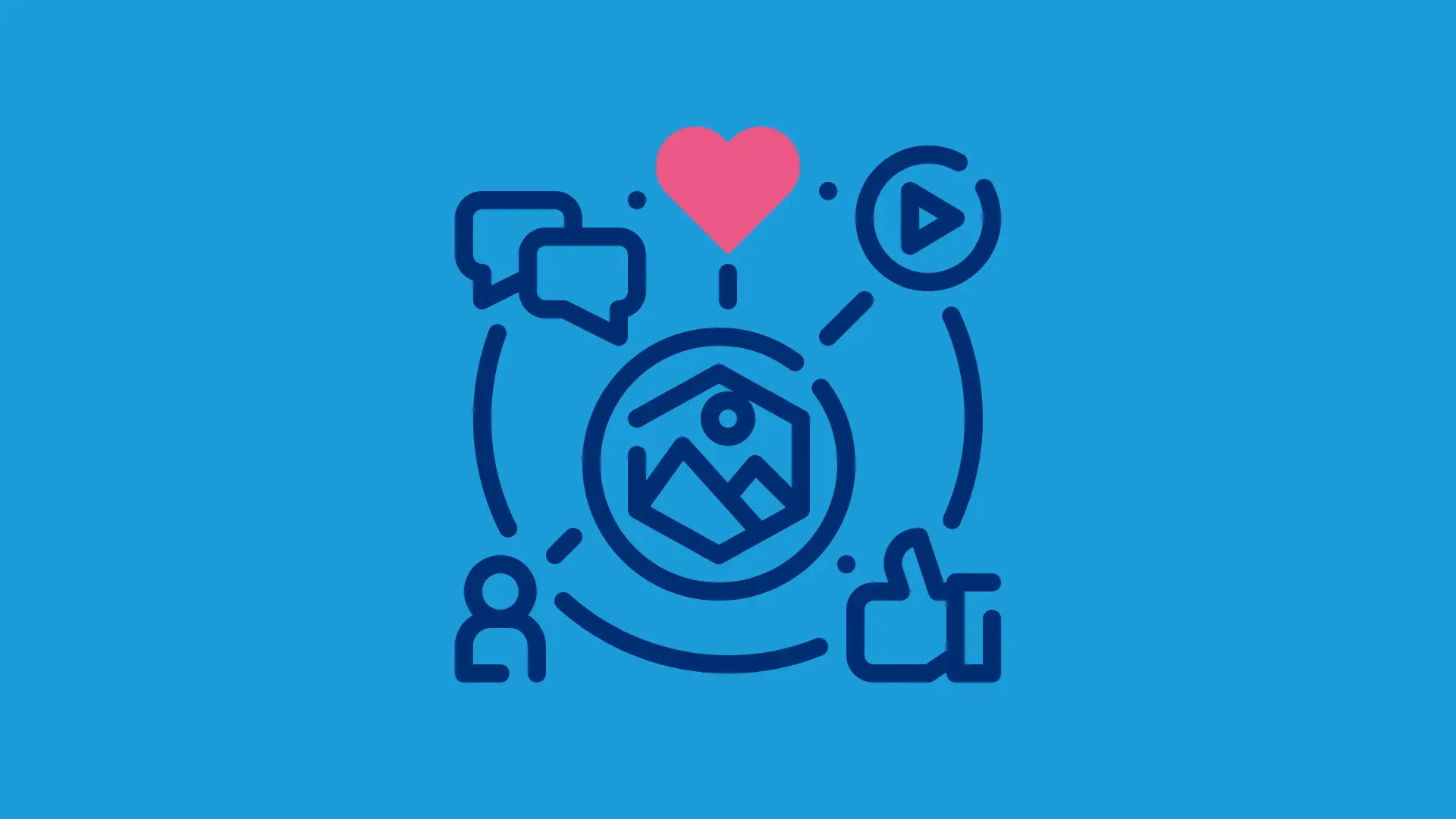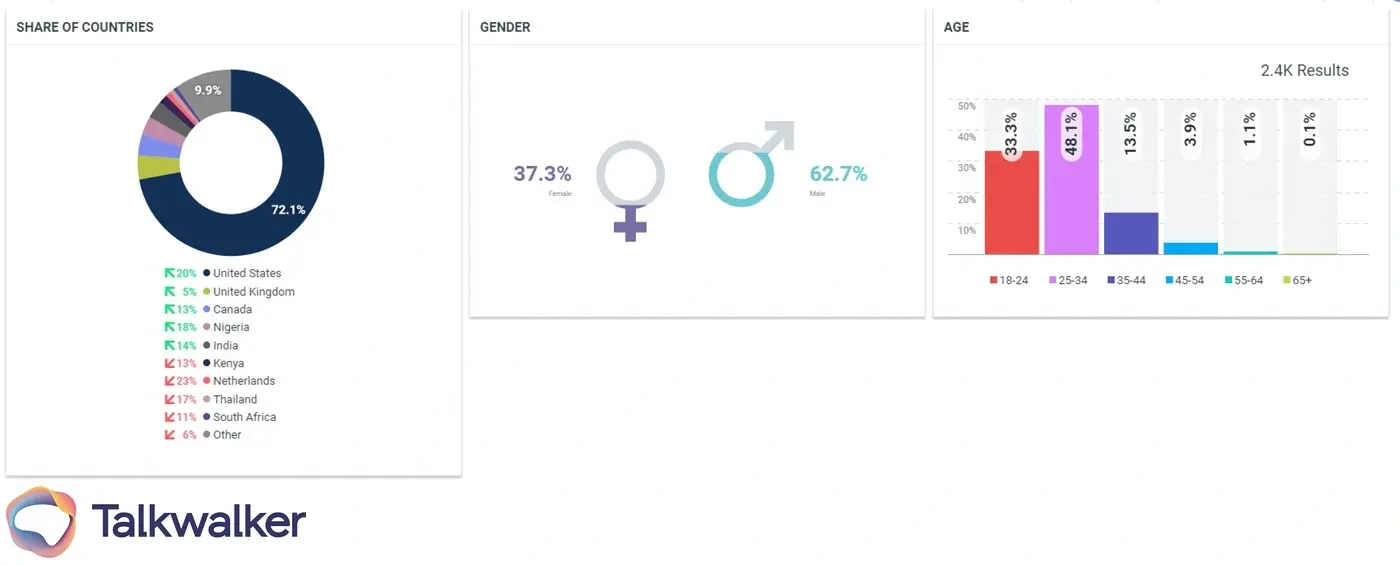How to Measure & Track Social Media Engagement
Discover how to measure and track social media engagement effectively. Learn the post types, tips, and tools for boosting engagement rates.
August 8, 2024

- What is social media engagement?
- What is a social media engagement rate?
- Why do you need to measure social media engagement?
- Types of social media engagement
- How to measure social media engagement
- Tips for measuring social media engagement
- What can you do to increase social media engagement?
- Tools to measure social media engagement
- Track all your social media engagement
What is social media engagement?
Put simply, social media engagement is when people actively react and respond to your social media posts.
It includes the total number of likes, comments, and shares. On some platforms just pausing on the post and not instantly scrolling away from it counts as engagement — these are known as impressions.
Engagement counts can be positive or negative — even things like reporting an ad as offensive counts as engagement according to Facebook and other social media platforms like LinkedIn.
By definition, some social media platforms regard engagement as the total number of actions people take on your social media posts.

Talkwalker Social Listening helps you measure overall social media engagement and compares results to previous periods
What is a social media engagement rate?
If engagement is how many times people interact with your company’s social media posts, the engagement rate is simply the comparison of engagement to possible engagement.
Essentially, your engagement rate reflects how well you’re keeping your followers glued to your content.
To calculate your social media engagement rate, divide your engagements by the total reach of your post, and multiply it by 100. This gives you a single score that you can track across your content and compare against future efforts.
The benchmark of what’s considered a “high” engagement rate varies by platform, but it’s much lower on Facebook or YouTube than on Instagram, where it sits between 3.5% and 6%.
Why do you need to measure social media engagement?
Measuring social media engagement provides important insights into the value you provide to your audience.
For example, it lets social media and marketing teams:
See what’s not working
If your engagement rate is quite low, you know your content isn’t quite hitting the mark for your target audience.
Spotting trends in posts using data lets you see what type of posts are working and what isn’t, so you can pivot your strategy.
If you’re unsure what works, you can try a new content strategy and test it using the data that makes up your engagement rate on your chosen platform.
… and what is
Being able to track your most successful posts can help you form the basis for your content.
There’s no doubt that content that performs well resonates with your audience — knowing the data helps you replicate this content or keep new content along the same lines to stay fresh.
Highlight areas of comparison
When you measure social media engagement, you’re able to identify where your content is over- or under-performing, and even compare your social media posts against your competitors’.
If you’re competitors are getting creative, the data will reveal this – allowing you to follow suit or pivot your strategy.
Types of social media engagement
When looking at how to increase social media engagement, it’s important to know what types of engagement there are.
Social media engagement can be broken down into two categories:
Passive engagement
Passive engagement, as the name implies, requires less effort. Generally, it looks at engagement metrics that require just a single button tap. Think likes, shares and retweets, for example.
Active engagement
Active engagement is when somebody feels compelled to take more time to respond to your post —and because it requires more effort, it’s generally considered more valuable.
Active social media engagements include comments, retweets with comments, or sharing in a private message with a note.
How to measure social media engagement
When it comes to boosting social media engagement, data is power.
Likes, shares, impressions, comments, viral lift, and sentiment all play a pivotal role in gauging how well social media campaigns perform.
However, these alone don’t tell you everything you need to know. There are dozens of metrics marketers can track like:
Clicks and clickthrough rate – The rate at which people click through to your products and services from a post or ad.
Audience growth rate — The rate at which your follower count grows over a given period.
Watch time (for video content) — If you make audio content — like podcasts – or video content, it’s possible to track how long people listen and engage with the content. The better the content, the more likely you’ll hang on to your audience for a longer period.
Engagements to number of followers ratio — Calculating the proportion of your followers that engage with your content. The higher the proportion of followers, the more they want to engage – and the better your content is.
Tips for measuring social media engagement
When measuring your social media engagement, there are a few things to bear in mind.
Some of the things you should consider when tracking social media engagement are:
Define clear goals
To improve your social media engagement metrics, you need to set goals and targets — without these, your content will be aimless, and you won’t achieve the results you’re looking for.
For example, say you want to grow your follower count by 10% during a period, with this goal in mind, you know to only create content with the sole purpose of bolstering visibility, rather than wasting time on content that’s optimized for a different purpose.
Use social media tools to track
Rather than trying to calculate engagement rates yourself, many social media tools can do this for you at the click of a button — letting you track the progress of your social media campaigns in real time.
A/B test your content
If you’re pivoting your original social media strategy, it’s crucial to monitor and test your new posts to make sure you’re heading in the right direction.
Say you’re looking for more engagement — and you’ve scheduled a backlog of posts to achieve this – isolate that set of posts for testing. If you’ve collected the data on the posts and your social media engagement rate hasn’t changed, you can trial new posts and find out what works.
Talkwalker’s Social Listening tool makes it effortless to monitor social media engagement.
Track engagement across 30 social networks, as well as brand mentions across 150 million websites, so you never miss an opportunity to engage with your audience.
{{cta('91430369778','justifycenter')}}
What can you do to increase social media engagement?
Instagram, Twitter, Facebook, and other platforms are full of brands doing their best to hold our attention.
However, well-crafted tweets and beautiful photos will only take a brand so far. Sometimes, you need to switch strategies to react.
Below, we outline the different types of social media engagement with examples:
You can ask for your engagement directly
The weekend is here 👏🏾 what #GLOSSBOMB we wearin out?? 🫦
— Fenty Beauty (@fentybeauty) January 20, 2023
This X post from Fenty Beauty in 2023 is a great example of a post that exists only to boost engagement numbers.
By asking the audience a simple question — that stimulates creativity and appeals to people’s natural desire to want to get likes of their own — it compels people to engage with the post.
Because Fenty Beauty is asking for fashion inspiration from its audience, it creates a sense of community – with followers and consumers sharing outfit ideas. This feeling drives infinitely more comments and interactions than just images and advertorial text alone.
You can let users generate content for them
We asked what made you enter your Crocs era. Anyone relate? #MyCrocsEra pic.twitter.com/9VQmOxkoUC
— Crocs (@Crocs) April 27, 2023
Sometimes, users generate advertorial content on social media without meaning to – often in response to a brand campaign.
One example of this approach came in 2023, when Crocs launched its #MyCrocsEra campaign, aiming to capitalize on its growing popularity among younger wearers.
The campaign urged consumers to post images of themselves wearing Crocs products, along with a story of how they bought their first pair.
In this example, the resulting content focuses entirely on the product, giving the brand a unique opportunity for product placement without lifting a finger.
Content like this from normal people stirs up a sense of urgency — like they want to be the ones in the photo doing the same thing. This relatability inevitably translates to more shares, clicks, and ultimately, sales.
You get creative to stir engagement
Some brands dare to get a bit more creative to drive social media engagement – producing content that is less obviously commercial and aimed more at starting conversations and driving interactions.
*clears throat* It's #NationalRoastDay on TikTok pic.twitter.com/YhNuzeZpuP
— Wendy's (@Wendys) April 12, 2023
Take this example from Wendy’s, which produces content every year for #RoastDay, going viral and stirring plenty of engagement on social media. Every year, the brand produces content on X – and more recently, TikTok too – ‘roasting’ customers and competitors with amusing jokes.
Not only has Wendy’s built brand awareness through its amusing social media content, but it also drives engagement through likes, shares, and replies.
Tools to measure social media engagement
There are many tools available for measuring social media engagement – each offering unique benefits depending on exactly what you’re trying to find out or calculate.
Most social media platforms even come with integrated tools for measuring engagement, including:
Facebook Audience Insights
Instagram Post Insights
YouTube Analytics (within the Creator Studio or Google Analytics).
However, these built-in engagement tracking features are often lacking in detail or insights, and often don’t give social media professionals or businesses the comprehensive data they’re looking for to shape their marketing decisions.
With this in mind, below we share our favorite tools for measuring social media engagement in more ways than just views and likes:
Talkwalker Social Listening | Social Media Listening Platform
Benefit from our complete range of analytics tools and you’ll:
Get a complete view of your brand health across multiple platforms.
Track mentions and measure your engagement based on demographics that matter like location, age, platform, or anything else you can imagine.
Find out what moments in big events get fans engaged in real time.

Dive into your Talkwalker Social Listening analytics to see which audience demographics are engaging with your brand
Hootsuite | Easy social media management
Hootsuite manages all your social channels in one place - making measuring your social media engagement easy.
Add in Talkwalker Social Listening, and you'll have consumer insights at your fingertips. Enabling you to create more engaging, trendy, relevant content. All of which will deliver more results for your business.
Snaplytics | Analytics for stories & Snapchat
Get all the analytics data you need from Instagram and Snapchat posts — even when they’ve disappeared.
Google Analytics | Report on social media referrals
Use Google Analytics to report on the value of your social media engagement on your wider business website. Track website referrals from your social media content and dive deeper into metrics like session duration, pages per session, and bounce rate, to find out how you can create more user-friendly content.
To learn more about these tools, and what else is on offer, check out the best social media engagement tools for brands
Track all your social media engagement
You can use Talkwalker Social Listening to track every engagement across your social media presence. As well as brand mentions across the web, and even sentiment analysis. Enabling you to react instantly to conversations around your brand quickly.
To learn more, just click below
{{cta('91430369778','justifycenter')}}
